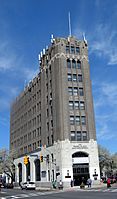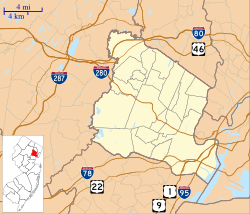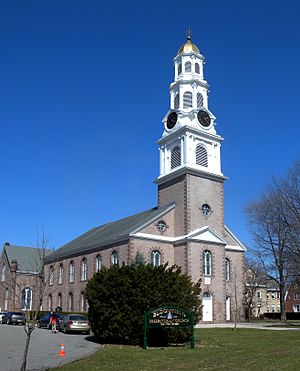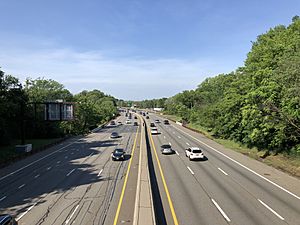Bloomfield, New Jersey facts for kids
Quick facts for kids
Bloomfield, New Jersey
|
|
|---|---|
|
Township
|
|
| Township of Bloomfield | |

Frank M. Leo Associates Building in downtown Bloomfield
|
|

Location in Essex County and the state of New Jersey.
|
|

Census Bureau map of Bloomfield, New Jersey
|
|
| Country | |
| State | |
| County | |
| Incorporated | March 23, 1812 |
| Named for | Joseph Bloomfield |
| Government | |
| • Type | Special Charter |
| • Body | Township Council |
| Area | |
| • Total | 5.36 sq mi (13.88 km2) |
| • Land | 5.34 sq mi (13.82 km2) |
| • Water | 0.02 sq mi (0.06 km2) 0.45% |
| Area rank | 268th of 565 in state 7th of 22 in county |
| Elevation | 174 ft (53 m) |
| Population | |
| • Total | 53,105 |
| • Rank | 36th of 566 in state 4th of 22 in county |
| • Density | 9,944.8/sq mi (3,839.7/km2) |
| • Density rank | 40th of 566 in state 6th of 22 in county |
| Time zone | UTC−05:00 (Eastern (EST)) |
| • Summer (DST) | UTC−04:00 (Eastern (EDT)) |
| ZIP Code |
07003
|
| Area code(s) | 862/973 (973 Exchanges: 259.281.429,566,680,743,748 |
| FIPS code | 3401306260 |
| GNIS feature ID | 1729714 |
Bloomfield is a township in Essex County, New Jersey, United States. As of the 2020 United States Census, the township's population was 53,105. It surrounds the Bloomfield Green Historic District.
Contents
History
The initial patent for the land that would become Bloomfield Township was granted to the English Puritan colonists of Newark, and the area assigned to Essex County in 1675, and Newark Township in 1693. From the 1690s to about the 1720s, much of the northern and eastern land was sold to descendants of New Netherland colonists who had settled Acquackanonk, and the remainder mostly to English families. Speertown (now Upper Montclair), Stone House Plains (now Brookdale), and Second River (now Belleville) were essentially Dutch, while Cranetown, Watsessing, and the Morris Neighborhood (now North Center) were predominantly English. Starting in the mid-18th century, the English and Dutch neighborhoods gradually integrated, with Thomas Cadmus being among the first Dutchmen to settle in an English neighborhood.
Numerous residents served in the Revolutionary War. No significant engagements occurred in Bloomfield, although the locale was on the Continental Army's retreat route after the Battle of Long Island; British and American troops conducted foraging operations; and General George Washington is believed to have visited at least two residences. The Green was set aside to commemorate the use of that space for drilling of militia.
The Presbyterian Society of Bloomfield (now the Bloomfield Presbyterian Church on the Green) was formed in 1794 in honor of then-brigadier Joseph Bloomfield, commander of New Jersey troops in the Whiskey Rebellion. About the same time, the Dutch Reformed Church of Stone House Plains (now Brookdale Reformed Church) was established. The two churches became integral institutions of southern and northern Bloomfield, respectively.
Bloomfield was incorporated as a township from portions of Newark Township by an act of the New Jersey Legislature on March 23, 1812. At the time, the Presbyterian parish's namesake was governor of New Jersey and had recently been appointed brigadier general for service in the looming War of 1812.
At the time it was incorporated, the township covered 20.52 square miles (53.1 km2) (almost four times its current area of 5.3 square miles (14 km2)) and included several municipalities which were formed from portions of Bloomfield during the course of the nineteenth century, including Belleville (created on April 8, 1839), Montclair (April 15, 1868), Woodside Township (March 24, 1869) and Glen Ridge (February 13, 1895). The Stone House Plains neighborhood was renamed as Brookdale in 1873.
In the township's first century, Brookdale farms thrived while southern Bloomfield industrialized, and the township's infrastructure, civil framework and social institutions developed. Several miles of the Morris Canal passed through Bloomfield. The Oakes woollen mill thrived as a major supplier to the Union army.
Bloomfield was incorporated as a town on February 26, 1900. In 1981, the town was one of seven Essex County municipalities to pass a referendum to become a township, joining four municipalities that had already made the change, of what would ultimately be more than a dozen Essex County municipalities to reclassify themselves as townships in order to take advantage of federal revenue sharing policies that allocated townships a greater share of government aid to municipalities on a per capita basis.
In the 20th century, GE, Westinghouse and Schering built major facilities, and among others, the Charms Candy Company was started and grew. After World War I, Brookdale's farms were developed into residential neighborhoods and supporting services. Substantial population growth continued into the 1950s. During World War II, while many Bloomfield men served in the armed forces, Bloomfield's farms and factories, largely staffed by women, supported the war effort. In the decades after the war, the township's industrial base steadily shut down with stricter environmental regulations, rising labor costs, and growing competition. These influences, as well as construction of the Garden State Parkway, further drove urban decay and related population turnover and stagnation through the latter part of the 20th century.
In the early 21st century, redevelopment of blighted and underutilized properties has further shifted Bloomfield towards being a primarily residential municipality.
Geography
According to the United States Census Bureau, the township had a total area of 5.328 square miles (13.801 km2), including 5.304 square miles (13.738 km2) of land and 0.024 square miles (0.063 km2) of water (0.46%).
Silver Lake (2010 total population of 4,243) is an unincorporated community and census-designated place (CDP) defined by the United States Census Bureau as of the 2010 Census that is split between Belleville (with 3,769 of the CDP's residents) and Bloomfield (474 of the total). Brookdale (2010 population of 9,239) is a CDP located entirely within Bloomfield.
Other unincorporated communities, localities and place names located partially or completely within the township include Halycon and Watsessing.
Demographics
| Historical population | |||
|---|---|---|---|
| Census | Pop. | %± | |
| 1820 | 3,085 | — | |
| 1830 | 4,309 | 39.7% | |
| 1840 | 2,528 | −41.3% | |
| 1850 | 3,385 | 33.9% | |
| 1860 | 4,790 | 41.5% | |
| 1870 | 4,580 | −4.4% | |
| 1880 | 5,748 | 25.5% | |
| 1890 | 7,708 | 34.1% | |
| 1900 | 9,668 | 25.4% | |
| 1910 | 15,070 | 55.9% | |
| 1920 | 22,019 | 46.1% | |
| 1930 | 38,077 | 72.9% | |
| 1940 | 41,623 | 9.3% | |
| 1950 | 49,307 | 18.5% | |
| 1960 | 51,867 | 5.2% | |
| 1970 | 52,029 | 0.3% | |
| 1980 | 47,792 | −8.1% | |
| 1990 | 45,061 | −5.7% | |
| 2000 | 47,683 | 5.8% | |
| 2010 | 47,315 | −0.8% | |
| 2020 | 53,105 | 12.2% | |
| Population sources: 1820-1920 1820-1910 1840 1850-1870 1850 1870 1870-1890 1880-1890 1890-1910 1900-1930 1930-1990 2000 2010 2020 |
|||
In comparison to the other municipalities in the U.S., the cost of living in Bloomfield was an average 20% higher than the U.S. average.
2010 Census
As of the census of 2010, there were 47,315 people, 18,387 households, and 11,768 families residing in the township. The population density was 8,920.5 per square mile (3,444.2/km2). There were 19,470 housing units at an average density of 3,670.7 per square mile (1,417.3/km2)*. The racial makeup of the township was 59.61% (28,205) White, 18.51% (8,757) Black or African American, 0.41% (193) Native American, 8.22% (3,891) Asian, 0.04% (21) Pacific Islander, 9.35% (4,423) from other races, and 3.86% (1,825) from two or more races. [[Hispanic (U.S. Census)|Hispanic or Latino of any race were 24.53% (11,606) of the population.
There were 18,387 households out of which 28.3% had children under the age of 18 living with them, 44.2% were married couples living together, 14.9% had a female householder with no husband present, and 36.0% were non-families. 29.5% of all households were made up of individuals, and 9.1% had someone living alone who was 65 years of age or older. The average household size was 2.54 and the average family size was 3.20.
In the township, the population was spread out with 21.2% under the age of 18, 9.1% from 18 to 24, 30.9% from 25 to 44, 26.8% from 45 to 64, and 12.0% who were 65 years of age or older. The median age was 37.7 years. For every 100 females there were 89.6 males. For every 100 females ages 18 and old there were 86.4 males.
The Census Bureau's 2006-2010 American Community Survey showed that (in 2010 inflation-adjusted dollars) median household income was $62,831 (with a margin of error of +/- $2,641) and the median family income was $77,936 (+/- $4,120). Males had a median income of $51,498 (+/- $1,805) versus $44,735 (+/- $2,867) for females. The per capita income for the township was $30,421 (+/- $1,122). About 5.8% of families and 7.4% of the population were below the poverty line, including 7.9% of those under age 18 and 7.9% of those age 65 or over.
Parks and recreation
Brookdale Park, established in 1928, covers over 121 acres (49 ha) in Bloomfield and Montclair, making it the third-largest park in Essex County, of which 77 acres (31 ha) are in Bloomfield. Watsessing Park, which is the county's fourth-largest park, covers 69.67 acres (28.19 ha) split between Bloomfield and East Orange (60 acres (24 ha) in Bloomfield), and features sections of the Second River and Toney's Brook flowing through the park. Both parks are administered by the Essex County Department of Parks, Recreation, and Cultural Affairs.
The Bloomfield Parks and Recreation Department administers eight parks covering 55.23 acres (22.35 ha).
Transportation
Roads and highways
As of May 2010[update], the township had a total of 95.39 miles (153.52 km) of roadways, of which 77.39 miles (124.55 km) were maintained by the municipality, 13.77 miles (22.16 km) by Essex County and 4.23 miles (6.81 km) by the New Jersey Turnpike Authority.
The major New Jersey highway artery that serves Bloomfield is the Garden State Parkway, the longest road in the state. It has four interchanges in the township. Interchanges 148 in the south of Bloomfield and 151 in the north are complete interchanges, while 149 and 150 are partials. The Parkway's Essex toll plaza is southbound just south of interchange 150 in the township. There are two service areas on the Parkway in Bloomfield, one for northbound and one southbound. Troop D of the New Jersey State Police, which patrols the full length of the Garden State Parkway, has a station in Bloomfield at northbound milepost 153.
County Road 506, 506 Spur and 509 also serve Bloomfield.
Commuter rail
South Bloomfield is served by two stations of the NJ Transit Montclair-Boonton Line to Hoboken Terminal or to Penn Station in Midtown Manhattan via the Secaucus Junction. About 55% of the weekday trains terminate in Penn Station via Midtown Direct. On weekends the line terminates in Hoboken. The Bloomfield train station is located off of Bloomfield Avenue in the downtown area. The Watsessing Avenue station is at the corner of Watsessing Avenue and Orange Street, and is located below ground.
Bloomfield used to be served by other passenger rail lines. The Rowe Street station was served by the Boonton Line until September 2002, when it was closed as part of the addition of Midtown Direct service to the township. The Walnut Street station, on the same line, was closed in 1953 when the Garden State Parkway was built through it.
Light rail
The Grove Street station on the Newark City Subway line of the Newark Light Rail at the south end of Bloomfield provides service to Newark Penn Station, created as part of an extension to Belleville and Bloomfield that opened in 2002. This station was part of the Orange Branch of the New York & Greenwood Lake Line of the Erie-Lackawanna Railroad with service to Jersey City which last saw passenger service in 1965. Freight service was discontinued in 2010 by Norfolk Southern with the loss of the last remaining shipper Hartz Mountain.
Buses
NJ Transit bus service is available to and from Newark on the 11, 27, 28, 29, 34, 72, 90, 92, 93 and 94 routes, with local service on the 709 bus line. In October 2009, the Go Bus 28 route was introduced, offering service nearly all day from Bloomfield Train Station to Newark Liberty International Airport.
Airports
Bloomfield is 7.5 miles (12.1 km) from Newark Liberty International Airport in Newark / Elizabeth, and 28.8 miles (46.3 km) from LaGuardia Airport in Flushing, Queens.
Points of interest
- Glendale Cemetery
- Holsten's Brookdale Confectionery, filming location of the final scene in the final episode of The Sopranos.
- The Oakes Estate, constructed in 1895 based on a design by Charles Granville Jones, was added to the National Register of Historic Places in 1981.
Notable people
People who were born in, residents of, or otherwise closely associated with Bloomfield include:
- Alaa Abdelnaby (born 1968), former NBA basketball player.
- James Avati (1912–2005), illustrator and paperback cover artist.
- Fallah Bahh (born 1985 as Francis Flores), professional wrestler signed with Impact Wrestling.
- Caleb Cook Baldwin (1820–1911), one of the first Presbyterian missionaries to Fuzhou (then Foochow), China.
- Arthur Hornbui Bell (1891–1973), Ku Klux Klan leader in New Jersey in the 1920s.
- Robert Birmelin (born 1933), figurative painter, printmaker and draughtsman.
- Seth Bingham (1882-1972), organist and prolific composer.
- William D. Bishop (1827–1904), member of the United States House of Representatives from Connecticut's 4th congressional district from 1857 to 1859.
- Elizabeth Blackwell (1821-1910), first woman doctor.
- Hank Borowy (1916–2004), Major League Baseball All-Star pitcher who played for the New York Yankees, Chicago Cubs, Philadelphia Phillies, Pittsburgh Pirates and Detroit Tigers.
- Randolph Bourne (1886-1918), radical writer and opponent of U.S. involvement in World War I.
- William Batchelder Bradbury (1816–1868), composer of the tune to "Jesus Loves Me" and many other popular hymns.
- Doug Brien (born 1970), placekicker who played for the New York Jets and six other teams in his 12-season NFL career.
- Kevin Burkhardt (born 1974), sportscaster who is a play-by-play voices for the NFL on FOX and a reporter with SportsNet New York, who is the field reporter during New York Mets telecasts.
- Thomas Cadmus (1736-1821), businessman, Revolutionary War officer and community leader.
- Marco Capozzoli (born 1988), placekicker who has played in the Arena Football League for the Jacksonville Sharks.
- Roger Cook (born 1930), graphic designer, photographer and artist.
- Marion Crecco (1930-2015), member of the New Jersey General Assembly from 1986 to 2002.
- Tom Cudworth (born 1964), screenwriter.
- Peter David (born 1956), science fiction and fantasy author known for his work in comic books and Star Trek novels.
- Frank Howard Dodd (1844-1916), publisher.
- Charles Warren Eaton (1857-1937), artist best known for his tonalist landscapes who lived in Bloomfield from 1888 until his death in 1937.
- Todd Edwards (born 1972), house music and UK Garage producer, an early pioneer of the genre of UK Garage.
- Bud Ellor (1905-1932), professional football player who spent one season in the National Football League in 1930, playing with the Newark Tornadoes.
- Alex Ferguson (1897-1976), pitcher in Major League Baseball who played for five different teams between 1918 and 1929.
- Tom Fleming (1951-2017), long-distance runner and two-time winner of the New York City Marathon.
- Connie Francis (born 1938), singer.
- Bill Geyer (1919-2004), halfback who played for three seasons for the Chicago Bears.
- Johnny Gibson (1905-2006), Olympic runner.
- Michael Giuliano (1915–1976), politician who served two terms in the New Jersey Senate.
- Roger Lee Hall (born 1942), composer and musicologist.
- Ernie Hambacher (1906–1990), American football fullback who played in the NFL for the Orange Tornadoes.
- Merton Hanks (born 1968), former NFL safety who played for the San Francisco 49ers and has been the NFL's Vice President of Operations.
- Larry Hesterfer (1878-1943), pitcher who played a single MLB game in 1901 with the New York Giants, in which he became the only player known to have hit into a triple play in his first major league at bat.
- Benjamin Holman (1930–2007), pioneering newspaper and television reporter who was one of the nation's few prominent black journalists.
- Jim Kelly (1884-1961), MLB outfielder.
- Charles Kinsey (1773–1849), U.S. Representative from New Jersey.
- Michael Knapp (born 2000), professional soccer player who plays as a midfielder for USL Championship club New York Red Bulls II.
- Mike Kochel (1916-1994), one of the seven blocks of granite at Fordham University, he played in the NFL for the Chicago Cardinals.
- Andy Kostecka (1921-2007), professional basketball player who played for the Indianapolis Jets.
- Ted Leo (born 1970), punk rock singer, songwriter and guitarist.
- Bob Ley (born 1955), ESPN sportscaster.
- Michael Maslin, cartoonist for The New Yorker.
- Keven McDonald (born 1956), basketball player who is best known for his collegiate career at the University of Pennsylvania from 1974 to 1978 with the Penn Quakers men's basketball team.
- Edward Page Mitchell (1852–1927), editorial and short story writer for The Sun.
- R. Stevie Moore (born 1952), lo-fi music singer/songwriter.
- Charles A. Morris (1853–1914), engineer and dredging inventor.
- Mike Olla (born 1994), professional soccer forward.
- Clayton Parros (born 1990), track and field sprinter who specializes in the 400-meter dash.
- Robert A. Pascal (1934–2021), politician who served as County executive of Anne Arundel County, Maryland from 1975 to 1982.
- Marion Post Wolcott (1910–1990), photographer who worked for the Farm Security Administration during the Depression.
- Charlie Puleo (born 1955), retired Major League Baseball pitcher who played from 1981 to 1989 with the New York Mets, Cincinnati Reds and Atlanta Braves.
- Philip Reilly (born 1952), fencer who competed in the team sabre event at the 1984 Summer Olympics.
- Andrew J. Robinson (c. 1843–1922), builder in New York City.
- Jack Robinson (1921-2000), professional baseball pitcher whose MLB career consisted of three games played in the Major Leagues for the Boston Red Sox in 1949.
- Don Savage, (1919-1961), Major League Baseball player for the New York Yankees in 1944 and 1945.
- Mark Sceurman, graphic artist who is co-creator and publisher of Weird NJ magazine.
- Anish Shroff (born 1982), ESPN sportscaster.
- Kristjan Sokoli (born 1991), American football defensive end.
- Robert Stempel (1933-2011), Chairman and CEO of General Motors.
- Frank Tripucka (1927–2013), pro football Denver Broncos' quarterback. Owned Trip Distribution, Inc.
- Kelly Tripucka (born 1959), pro basketball player for several teams, including the New Jersey Nets and New York Knicks. The Tripuckas are father and son, and both played their sports at the University of Notre Dame.
- Todd Tripucka (born 1954), former basketball player.
- Marlene VerPlanck (1933-2018), jazz and pop vocalist whose body of work centered on big band jazz, the American songbook and cabaret.
- E. Duke Vincent (born 1932 as Edward Ventimiglia), television producer, and was from 1960 to 1961 a naval aviator who was a member of the famed Blue Angels flying team, had a 40-year career in television writing and production, involving 2,300 hours of television.
- Alexander Wilson (1766–1813), the Father of American Ornithology, lived in Bloomfield for several months in 1801, where he was employed as a schoolteacher.
- Dick Zimmer (born 1944), former member of the United States House of Representatives who was the Republican candidate for United States Senate in 1996 and 2008.
Education
Primary and secondary schools
Public schools
The Bloomfield Public Schools serve students in pre-kindergarten through twelfth grade. As of the 2017–18 school year, the district, comprised of 11 schools, had an enrollment of 6,487 students and 544.0 classroom teachers (on an FTE basis), for a student–teacher ratio of 11.9:1. Schools in the district (with 2017-18 enrollment data from the National Center for Education Statistics) are Early Childhood Center at Forest Glen (151 students; in grades PreK-2), Berkeley Elementary School (451; K-6), Brookdale Elementary School (338; K-6), Carteret Elementary School (415; K-6), Demarest Elementary School (518; K-6), Fairview Elementary School (550; K-6), Franklin Elementary School (361; K-6), Oak View Elementary School (384; K-6) and Watsessing Elementary School (323; K-6), Bloomfield Middle School (940; 7–8) and Bloomfield High School / Bridges Academy (1,979; 9-12).
As of the 2012–13 school year, the Bloomfield Public Schools had an actual Budgetary Per Pupil Cost of $11,848 (which is 16.4% below the statewide group average was $14,173), while Total Spending Per Pupil for the district was $15,848 (which is 16.0% below the $18,867 statewide).
Bloomfield Tech High School is a regional, countywide magnet public high school that offers occupational and academic instruction for students in Essex County, as part of the Essex County Vocational Technical Schools.
Catholic schools
Saint Thomas the Apostle Parish School, which serves grades K-8, is operated under the supervision of the Roman Catholic Archdiocese of Newark.
Colleges and universities
Bloomfield College, a liberal arts college founded in 1868, is in downtown Bloomfield near the town green. The college has approximately 2,000 students and is affiliated with the Presbyterian Church.
See also
 In Spanish: Bloomfield (Nueva Jersey) para niños
In Spanish: Bloomfield (Nueva Jersey) para niños







